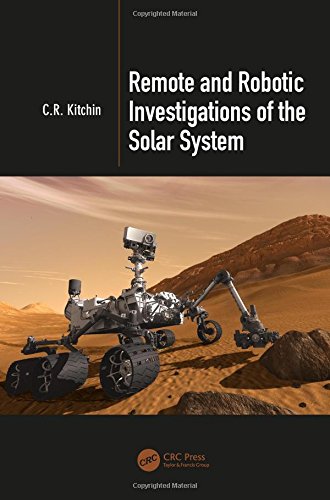

Most ebook files are in PDF format, so you can easily read them using various software such as Foxit Reader or directly on the Google Chrome browser.
Some ebook files are released by publishers in other formats such as .awz, .mobi, .epub, .fb2, etc. You may need to install specific software to read these formats on mobile/PC, such as Calibre.
Please read the tutorial at this link. https://ebooknice.com/page/post?id=faq
We offer FREE conversion to the popular formats you request; however, this may take some time. Therefore, right after payment, please email us, and we will try to provide the service as quickly as possible.
For some exceptional file formats or broken links (if any), please refrain from opening any disputes. Instead, email us first, and we will try to assist within a maximum of 6 hours.
EbookNice Team

Status:
Available4.8
16 reviews
ISBN 10: 0367845067
ISBN 13: 9780367845063
Author: C R Kitchin
Interest in and knowledge of the techniques utilised to investigate our solar system has been growing rapidly for decades and has now reached a stage of maturity. Therefore, the time has now arrived for a book that provides a cohesive and coherent account of how we have obtained our present knowledge of solar system objects, not including the Sun. Remote and Robotic Investigations of the Solar System covers all aspects of solar system observations: the instruments, their theory, and their practical use both on Earth and in space. It explores the state-of-the-art telescopes, cameras, spacecraft and instruments used to analyse the interiors, surfaces, atmospheres and radiation belts of solar system objects, in addition to radio waves, gamma rays, cosmic rays and neutrinos. This book would be ideal for university students undertaking physical science subjects and professionals working in the field, in addition to amateur astronomers and anyone interested in learning more about our local astronomical neighbours.
Part I The Detection and Investigation of Solar System Objects via Electromagnetic Radiation
Chapter 1 The Extended Optical Region
1.1 Introduction
1.2 Telescopes and Cameras
1.2.1 Reflecting Cameras
1.2.1.1 Prime Focus Systems
1.2.1.2 Cassegrain Systems
1.2.1.3 Ritchey–Chrétien Systems
1.2.1.4 Catadioptric Systems
1.2.1.5 Gregorian Systems
1.2.1.6 Custom-Designed Systems
1.2.2 Refracting Cameras
1.2.2.1 Telescope-Type Systems
1.2.2.2 Camera-Type Systems
1.2.2.3 Panoramic Systems
1.3 Spectroscopy and Spectrographs
1.3.1 Introduction
1.3.2 Basic Spectroscopy
1.3.3 Spectrographs
1.3.4 Spectral Features
1.3.5 Examples of Spectrographic Instruments
1.4 Detectors
1.4.1 Electron–Hole Pair Production-Based Detectors
1.4.1.1 Introduction
1.4.1.2 CCDs
1.4.1.3 Complementary Metal-Oxide Semiconductor Detectors
1.4.1.4 Photodiodes
1.4.2 Thermal Detectors
1.4.3 Photoelectric Effect-Based Detectors
1.4.3.1 Introduction
1.4.3.2 Microchannel Plates
1.4.3.3 Photomultipliers
1.4.3.4 Image Intensifiers
1.4.3.5 Detectors of Historical Interest
Chapter 2 Microwave and Radio Regions
2.1 Introduction
2.2 Telescopes, Receivers and Detectors
2.3 Direct Emissions from Solar System Objects
2.3.1 Introduction
2.3.2 Space-Based Observations
2.4 Radar
2.4.1 Introduction
2.4.2 Physical Principles of Radar Systems
2.4.3 Terrestrially Based Instruments
2.4.4 Spacecraft-Based Instruments
2.4.4.1 Introduction
2.4.4.2 Synthetic Aperture Radar
2.4.4.3 Imaging Radar Spacecraft Missions
2.4.4.4 Altitude, Doppler, Terrain and Other Radars
2.4.4.5 Ground-Penetrating Radar
2.4.4.6 Occultations
2.5 Spectroscopy
Chapter 3 X-Ray and γ Ray Regions
3.1 Introduction
3.1.1 Early Observations
3.1.1.1 X-Rays
3.1.1.2 Gamma Rays
3.1.2 X- and γ Ray Sources
3.2 Detectors
3.2.1 Introduction
3.2.2 Proportional Counters and Related Instruments
3.2.3 Scintillation Detectors
3.2.4 Microchannel Plates and Related Instruments
3.2.5 Solid State Detectors and Related Instruments
3.2.5.1 Charge-Coupled Devices
3.2.5.2 Semiconductor-Based Detectors
3.2.5.3 Calorimeter
3.3 Imagers
3.3.1 Multi-Layer Reflectors
3.3.2 Glancing Incidence Reflectors
3.3.2.1 Macroscopic Systems
3.3.2.2 Microscopic Systems
3.3.3 Collimators
3.3.3.1 Pin-Hole Cameras
3.3.3.2 Honeycomb Collimators
3.3.4 Coded Masks
3.4 Spectroscopes
3.4.1 Grating-Based Spectroscopes
3.4.1.1 Transmission Gratings
3.4.1.2 Reflection Gratings
3.4.2 Bragg Diffraction-Based Spectrometers
Part II The Detection and Investigation of Sub-Atomic, Atomic and Molecular Particles
Chapter 4 Detectors
4.1 Introduction
4.2 Detectors
4.2.1 Geiger Counters
4.2.2 Ion Chambers
4.2.3 Proportional Counters
4.2.4 Scintillation Detectors
4.2.5 Microchannel Plates
4.2.5.1 Channel Electron Multiplier
4.2.6 Solid State Detectors
4.2.6.1 Semiconductors and the Band Structure of Solids
4.2.6.2 Solid State Detectors
4.2.7 Transition Radiation Detectors
4.2.8 Calorimeter
4.2.9 Čerenkov Detectors
Chapter 5 Ion Optics and Charged Particle Instrumentation
5.1 Introduction
5.2 Ion Optics and Charged Particle Instrumentation
5.2.1 Electrostatic Analyser
5.2.2 Electrostatic Lenses
5.2.3 Electrostatic Prisms
5.2.3.1 Quadrupole Beam Deflector
5.2.4 Magnetic Interactions
5.2.4.1 Introduction
5.2.4.2 Magnetic Lenses
5.2.5 Velocity Selectors and Spectrometers
5.2.5.1 Velocity Selector
5.2.5.2 Velocity Spectrometer
5.2.5.3 Ion Drift Meters
5.2.6 Mass Spectrometers
5.2.6.1 Introduction
5.2.6.2 Magnetic Sector Mass Spectrometer
5.2.6.3 Electric Fields
5.2.6.4 Time-of-Flight Mass Spectrometer
5.2.6.5 Future Usage of Mass Spectrometers
Chapter 6 Neutral Particles
6.1 Introduction
6.2 Neutron Detection
Part III Direct Sampling and Other Investigative Methods
Chapter 7 Direct Sampling Instruments
7.1 Introduction
7.2 Surface
7.2.1 Microscopy
7.2.2 Spectroscopy
7.2.2.1 Thermal Emissions
7.2.2.2 Solids
7.2.2.3 Gases
7.2.2.4 Raman Spectroscopy
7.2.2.5 X-Ray Fluorescence Spectroscopy and X-Ray Diffraction
7.2.2.6 Alpha Particle Spectrometry
7.2.2.7 Mössbauer Spectroscopy
7.2.3 Chemical and Biological Analyses
7.2.3.1 Introduction
7.2.3.2 Gas Chromatograph
7.2.3.3 Gas Chromatograph–Mass Spectrometer Instruments
7.2.3.4 Biological Investigations
7.2.3.5 Neutron-Based Instruments
7.2.3.6 Wet Chemistry
7.2.4 Physical Properties
7.2.4.1 Temperature and Thermal Conductivity or Inertia
7.2.4.2 Electricity and Magnetism
7.2.4.3 Density and Refractive Index
7.2.5 Ionising Radiation Levels
7.2.6 Sampling
7.2.6.1 Introduction
7.2.6.2 Passive Sampling
7.2.6.3 Active Sampling
7.2.7 Ground Truth
7.2.8 Retro-Reflectors
7.3 Sub-Surface
7.3.1 Radar
7.3.2 Seismometry
7.3.2.1 Introduction
7.3.2.2 Spacecraft Seismometry
7.4 Atmosphere
7.4.1 Spectroscopy
7.4.2 Nephelometry
7.4.3 Pressure
7.4.4 Temperature
7.4.5 Humidity
7.4.6 Wind
7.4.7 Acoustics
7.5 Interplanetary Medium
7.5.1 Large-Scale Magnetic Fields
7.5.1.1 Search Coil Magnetometer
7.5.1.2 Flux Gate Magnetometer
7.5.1.3 Helium Magnetometer
7.5.2 Electric Fields
7.5.2.1 Langmuir Wave Instruments
7.5.2.2 Langmuir Probe Instruments
7.5.2.3 Electron Drift
7.5.3 Interplanetary Dust
Chapter 8 Accelerations
8.1 Introduction
8.2 Spacecraft-Borne Accelerometers
8.3 Gravity Studies
Tags: C R Kitchin, Remote, Robotic